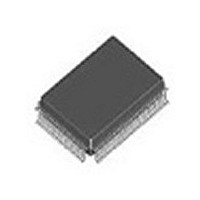SLXT973QCA3V 856775 Intel, SLXT973QCA3V 856775 Datasheet - Page 28

SLXT973QCA3V 856775
Manufacturer Part Number
SLXT973QCA3V 856775
Description
Manufacturer
Intel
Datasheet
1.SLXT973QCA3V_856775.pdf
(88 pages)
Specifications of SLXT973QCA3V 856775
Lead Free Status / RoHS Status
Not Compliant
- Current page: 28 of 88
- Download datasheet (2Mb)
LXT973 10/100 Mbps Dual-Port Fast Ethernet PHY Transceiver
3.3.8.3
3.4
3.4.1
3.4.2
3.4.2.1
28
Figure 7. Port Address Scheme
Hardware Control Interface
The LXT973 provides a Hardware Control Interface for applications where the MDIO is not
desired. Refer to
Operating Requirements
Power Requirements
The LXT973 requires five power supply inputs: VCCD, VCCR, VCCT, VCCPECL, and VCCIO.
The digital and analog circuits require 2.5V supplies (VCCD, VCCR, and VCCT). These inputs
may be supplied from a single source although decoupling is required to each respective ground.
The fiber VCCPECL supply can be connected to either 2.5V or 3.3V.
A separate power supply may be used for MII and MDIO (VCCIO) interfaces. The power supply
may be either +2.5V or +3.3V. VCCIO should be supplied from the same power source used to
supply the controller on the other side of the interface. As a matter of good practice, these supplies
should be as clean as possible.
Clock Requirements
Reference Clock / External Oscillator
The LXT973 requires a constant enabled reference clock (REFCLK). REFCLK’s frequency must
be 25 MHz. Considering overall system performance first, the clock is best derived by providing a
crystal-based oscillator. PLL-based oscillators with known stability may also be used. In general,
an oscillator-based clock source is recommended over a derived clock due to frequency stability
Port 0
Port 1
LXT973
Figure 16, “LXT973 Initialization Sequence” on page 47
Example ADDR<4.1> = 0001
PHY ADDR<4.1> (BASE+0)
ex. 2
PHY ADDR<4.1> (BASE+1)
ex. 3
BASE ADDR<4.1>
Port 0 = 2
Port 1 = 3
for additional details.
Rev. Date: March 1, 2002
Document #: 249426
Revision #: 002
Datasheet
Related parts for SLXT973QCA3V 856775
Image
Part Number
Description
Manufacturer
Datasheet
Request
R

Part Number:
Description:
Microprocessor: Intel Celeron M Processor 320 and Ultra Low Voltage Intel Celeron M Processor at 600MHz
Manufacturer:
Intel Corporation

Part Number:
Description:
Intel 82550 Fast Ethernet Multifunction PCI/CardBus Controller
Manufacturer:
Intel Corporation
Datasheet:

Part Number:
Description:
Intel StrataFlash memory 32 Mbit. Access speed 120 ns
Manufacturer:
Intel Corporation
Datasheet:

Part Number:
Description:
Intel StrataFlash memory 32 Mbit. Access speed 120 ns
Manufacturer:
Intel Corporation
Datasheet:

Part Number:
Description:
Intel StrataFlash memory 64 Mbit. Access speed 150 ns
Manufacturer:
Intel Corporation
Datasheet:

Part Number:
Description:
Intel StrataFlash memory 32 Mbit. Access speed 100 ns
Manufacturer:
Intel Corporation
Datasheet:

Part Number:
Description:
DA28F640J5A-1505 Volt Intel StrataFlash Memory
Manufacturer:
Intel Corporation
Datasheet:

Part Number:
Description:
5 Volt Intel StrataFlash?? Memory
Manufacturer:
Intel Corporation
Datasheet:

Part Number:
Description:
5 Volt Intel StrataFlash?? Memory
Manufacturer:
Intel Corporation

Part Number:
Description:
Intel 6300ESB I/O Controller Hub
Manufacturer:
Intel Corporation
Datasheet:

Part Number:
Description:
Intel 82801DB I/O Controller Hub (ICH4), Pb-Free SLI
Manufacturer:
Intel Corporation
Datasheet:

Part Number:
Description:
Intel 82801FB I/O Controller Hub (ICH6)
Manufacturer:
Intel Corporation
Datasheet:

Part Number:
Description:
Intel Strataflash Memory28F128J3 28F640J3 28F320J3
Manufacturer:
Intel Corporation
Datasheet:

Part Number:
Description:
Controllers, Intel 430TX PCIset: 82439TX System Controller (MTXC)
Manufacturer:
Intel Corporation










